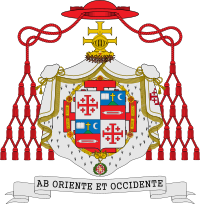Eugène Tisserant facts for kids
Quick facts for kids His Eminence Eugène Tisserant |
|
|---|---|
| Dean of the College of Cardinals | |

Photograph by Walter Sanders, April 1948
|
|
| Church | Roman Catholic Church |
| Appointed | 13 January 1951 |
| Reign ended | 21 February 1972 |
| Predecessor | Francesco Marchetti Selvaggiani |
| Successor | Amleto Giovanni Cicognani |
| Other posts |
|
| Orders | |
| Ordination | 4 August 1907 |
| Consecration | 25 July 1937 by Eugenio Pacelli |
| Created Cardinal | 15 June 1936 |
| Rank | Cardinal Bishop |
| Personal details | |
| Birth name | Eugène Gabriel Gervais Laurent Tisserant |
| Born | 24 March 1884 Nancy, France |
| Died | 21 February 1972 (aged 87) Albano Laziale, Province of Rome, Italy |
| Nationality | French |
| Denomination | Roman Catholic |
| Previous post |
|
| Styles of Eugène Tisserant |
|
|---|---|
 |
|
| Reference style | His Eminence |
| Spoken style | Your Eminence |
| Informal style | Cardinal |
| See | Porto e Santa Rufina (suburbicarian), Ostia (suburbicarian) |
Eugène Tisserant (born March 24, 1884 – died February 21, 1972) was an important French cardinal in the Catholic Church. He became a cardinal in 1936 and was a key member of the Roman Curia, which is like the Pope's main administrative team.
Contents
Early Life and Education
Eugène Tisserant was born in Nancy, France. From 1900 to 1904, he studied many subjects at a seminary in Nancy. These included theology, Sacred Scripture, and ancient languages like Hebrew and Syriac.
He was known for being very good at languages. People said he could speak thirteen different languages. These included Amharic, Arabic, Akkadian, English, his native French, German, Greek, Hebrew, Italian, Latin, Persian, Russian, and Syriac.
After his studies, he went to Jerusalem to learn more. However, he returned to France in 1905 to serve in the army. On August 4, 1907, he became a priest.
Career in the Vatican
Tisserant worked as a professor and curator at the Vatican Library from 1908 to 1914. During World War I, he served as an intelligence officer for the French Army. After the war, he returned to the Vatican Library. He became the assistant librarian in 1919 and later the Pro-Prefect in 1930.
In 1936, Pope Pius XI made Tisserant a Cardinal Deacon. A cardinal is a high-ranking official in the Catholic Church, usually chosen by the Pope. Cardinals often help the Pope and elect new Popes.
In 1937, Tisserant became an Archbishop. He was consecrated by Cardinal Eugenio Pacelli, who later became Pope Pius XII. Tisserant then took part in the conclave (the meeting to elect a new Pope) that chose Pacelli as Pope Pius XII.
Cardinal Tisserant held many important jobs in the Roman Curia. He was the secretary for the Congregation for the Oriental Churches (1936–1959), which deals with Eastern Catholic Churches. He also led the Pontifical Biblical Commission (1938–1946) and was in charge of ceremonies (1951–1967). From 1957 to 1971, he was the head librarian and archivist for the Vatican.
During World War II, Tisserant wanted to return to France to serve in the army. However, Pope Pius XII asked him to stay at the Vatican Library.
Important Roles and the Second Vatican Council
In 1946, Pope Pius XII made Tisserant a Cardinal Bishop. From 1947 to 1951, he was the vice-dean of the College of Cardinals. This group includes all the cardinals in the Catholic Church. On January 13, 1951, he became the Dean, which is the leader of the College of Cardinals.
As Dean, he led the funeral services for Popes Pius XII and John XXIII. He also presided over the conclaves in 1958 and 1963 that elected their successors. In the 1958 conclave, many people thought he might be elected Pope himself.
In 1961, he was chosen as a member of the Académie Française, a very important French organization that protects the French language.
From 1962 to 1965, Cardinal Tisserant attended the Second Vatican Council. This was a major meeting of Catholic bishops from all over the world to discuss the Church's role in the modern world. As Dean, he played a significant role, including signing all the official documents of the Council after Pope Paul VI.
In 1962, Tisserant also became the Grand Master of the Order of the Holy Sepulchre. This is a Catholic order of knighthood that supports Christians in the Holy Land. He held this position until he passed away.
In 1970, Pope Paul VI made new rules that cardinals over 80 years old could not vote in papal conclaves. Cardinal Tisserant, who was 86 at the time, disagreed with this rule. He believed that a cardinal's health, not just age, should decide if they could vote.
Death
Cardinal Eugène Tisserant died on February 21, 1972, at the age of 87, from a heart attack. Pope Paul VI attended his funeral service.
He is buried in the Basilica of Porto e Santa Rufina in Rome, Italy.
See also
 In Spanish: Eugène Tisserant para niños
In Spanish: Eugène Tisserant para niños
- Cardinal electors in Papal conclave, 1939
- Cardinal electors in Papal conclave, 1958
- Cardinal electors in Papal conclave, 1963


